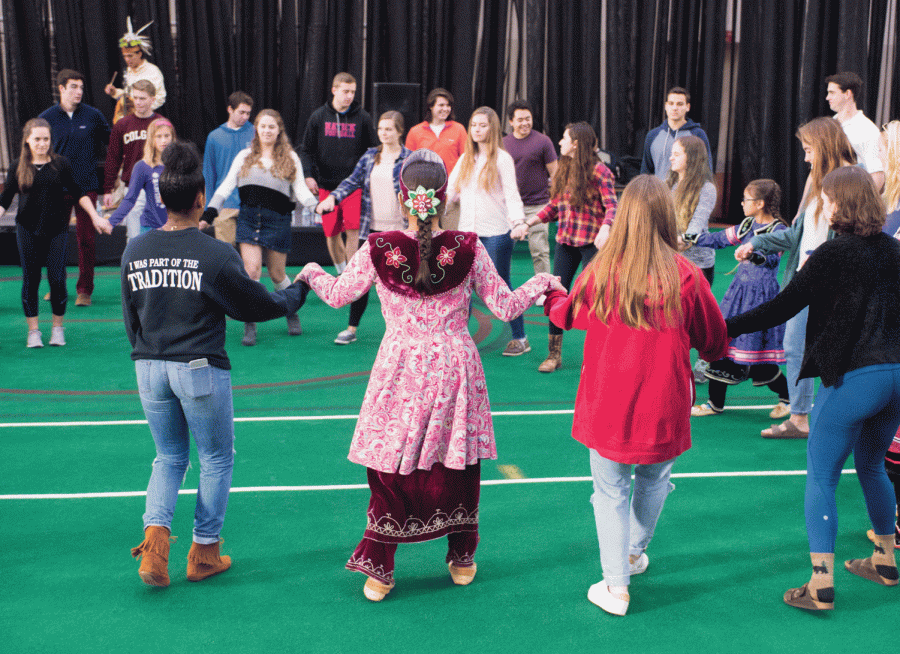Colgate Welcomes Native American Festival
“I learned to weave baskets from an elder, when I was 20,” said Ronnie-Leigh Goeman, an artist from Onondaga. “But I stopped when I left home, as I went to college, got married and had kids. But sometimes I went home, looked at my grandmother’s sweet baskets, and again started to want to weave baskets. I picked it up then. Now besides weaving baskets, I am also a social worker. But baskets have still a place in my heart.”
On October 21, Colgate welcomed more than 700 guests to the Native American Festival. The festival took place in Sanford Fieldhouse from 9:30 a.m. to 5 p.m., with music and dance performances, a children’s corner, artwork demonstrations, object displays and food carts. The festival invited and attracted Native American peoples from the Seneca, Cayuga, Onondaga, Oneida, Mohawk, Tuscarora, Navajo (Diné), Blackfoot and other nations. It featured beautiful artworks on display and various peoples in action. Goeman was one of the Native American artists present.
Besides Goeman, many other Native American artists shared beautiful, meaningful stories.
“When I was very young I started collecting stones,” said Tom Huff, an artist from the Seneca Nation. “Then I started carving them. I love their colors and their textures. I learned to do sculpture on my own, making my cultural objects. Later I went to Santa Fe to study sculpture formally under a teacher.”
“Native artists in our area were the first impetus for organizing an arts and culture festival at Colgate,” said Associate Professor and Director of Native American Studies Professor Carol Ann Lorenz, the main organizer of this event.
“Some artists based at Onondaga asked if I would create a space at Colgate for the celebration of Native American culture, as well as to provide local Native artists with another, much needed venue at which they might sell their handmade goods. The selling of art and craft items benefits Native communities both economically as well as by giving elders a reason to pass their craft traditions to the next generations.”
According to Lorenz, some of the festival’s objectives include bringing Native Americans and non-Indians together in an environment that fosters mutual respect and understanding. This serves to provide Colgate students and Hamilton residents an opportunity for learning about contemporary Native people and their arts and culture. As a whole, this event is both entertaining and educational, and kicks off the celebration of Native Heritage Month in November.
This festival is the hard work of Lorenz. It is also the collective effort of the Colgate community, especially the students.
“I was very much in favor of the idea, but needed the next catalyst – student enthusiasm – before proceeding,” Lorenz said.
“Fortunately, Leyosta Hall arrived on campus with the energy to devote to revitalizing the Native American Student Association. Leyosta, a Mohawk student living in the Onondaga community, also danced with the Haudenosaunee Singers and Dancers. Together, Native American Studies and NASA (now called Native American Student Allies), put together the first Native American Arts & Culture Festival in 2001. Konosioni has made a big impact in our ability to offer the children’s corner activities, especially, and its members have helped in other ways. ALANA Ambassadors also help with setting up and taking down the festival,” Lorenz said.
The project has expanded over time. In 2001, the festival was small, but in the past few years, almost every festival attracted at least 1,000 people.
Junior Angie Diaz felt the festival was significant.
“It is great to see them here together. Especially since [the] Colgate campus was Native American,” she said.
Sophomore Tuyen Ta Hoang also expressed her gratitude for seeing such an event and the communities present.
“It’s really cool what they are doing. I love to see the presence of such an active Native American community, with so many cool cultural objects, especially on such a white campus,” Hoang said.
Lorenz was satisfied with this year’s festival, but hopes to make further changes in the years to come.
“My hope for the next year, my final year before retirement, is to make the festival even more for Native people. While the festival is certainly for Native people now, I think my last effort will be focussed on local Haudenosaunee communities,” she said.
Contact Annie Wang at [email protected].







